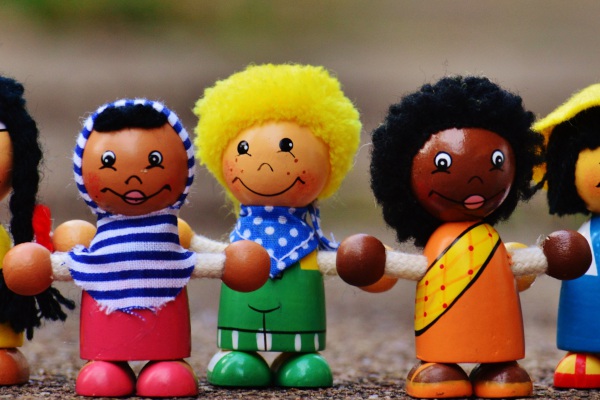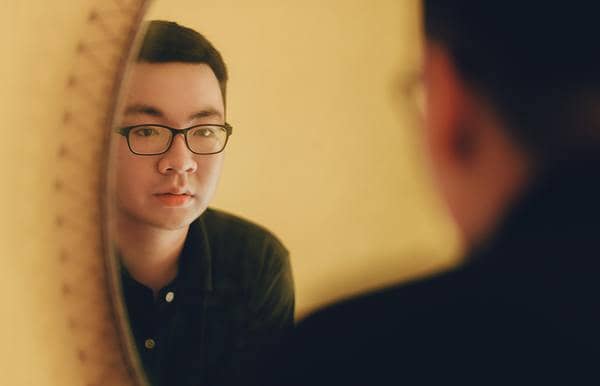 Reflecting participant’s experiences of completing a new psychotherapy through a mirror – “It’s like the Mad Hatter’s Tea Party”
Reflecting participant’s experiences of completing a new psychotherapy through a mirror – “It’s like the Mad Hatter’s Tea Party”
25 June 2025
Note from Dr. Francesca: “I’m honoured to invite Dr Ross Taylor to share the findings of his Doctorate in Clinical Psychology research into Mindful Interbeing Mirror Therapy (MIMT) at the University of Birmingham.”
As a research group, we have completed our first research study into what the experience of taking part in Mindful Interbeing Mirror Therapy (MIMT) is like. Our participants outlined how MIMT’s weird and wonderful techniques helped them cultivate self-compassion and how their experience offered them lasting hope in their lives. We are hopeful our research can help promote interest among clinicians and researchers of the approach.
What is MIMT and why research it?
Mindful Interbeing Mirror Therapy (MIMT) is a recently developed, trauma-focused psychotherapy. Drawing in part from other contemporary trauma therapy models, MIMT is unique in its approach; for example, the patient and therapist interact through a large mirror (see Dr Francesca’s blog post regarding what MIMT entails). The focus of MIMT is to help patients build an experiential connection with avoided emotional states (thought to be linked to an individual experiencing adverse events) alongside the therapist, who acts as an emotional regulator. Despite MIMT being used in various locations across the UK (and beyond!), there is limited evidence regarding its processes, effectiveness, or experience. Consequently, in exploring perspectives on MIMT, we proposed this would provide an initial knowledge platform to develop a better understanding of how MIMT is viewed by those who take part in it.
How was the research undertaken?
Using an established qualitative methodology – Interpretative Phenomenological Analysis – we explored the experiences of six individuals who have completed MIMT. Within this group were those who had previously completed a different type of therapy so we could better clarify what it was about MIMT, rather than just what experiences of therapy were like more broadly. Once our participant pool was identified, we then completed longer-form and semi-structured interviews, mainly asking what their experience was like and how they made sense of the process. Ethical approval was provided and monitored within the University of Birmingham.
What did we find?
Results indicated that participants felt the emotional intensity of engaging with the mirror – for example, looking at themselves as they were talking helped them to build their understanding of themselves. This building connection to themselves was reflected in them noticing with more clarity their vulnerability (e.g., their emotional pain) as well as the shame they felt for experiencing this. Specific techniques of MIMT, including the use of the mirror and therapist dialogue, were reported to help participants feel emotions became more tangible, whilst other ineffable experiences provided lasting hope. One participant named this process as being “like the Mad Hatter’s tea party” – in the sense that through an unusual process it gave them “more chairs” and choices in how they can live their life, for example, with less shame. In addition to the techniques of MIMT, the therapeutic relationship was consistently described as essential. Whilst sharing elements with other therapeutic approaches, our findings suggested that MIMT appears promising for individuals distressed through past traumatic experiences.
What’s next?
Our research highlighted several clinical suggestions, including the importance of good supervision and training in MIMT, particularly given the intensity of the therapy. We also found that whilst some participants described having sudden insights as a result of MIMT, other participants did not, which may be validating information for current and future MIMT clients. We are currently in the process of identifying and seeking peer review. If you are interested in hearing more about this research, please contact us!
Get in touch
Ask about this research using the contact form.
 Image reproduced with the permission of the subject. All rights reserved.
Image reproduced with the permission of the subject. All rights reserved.
08 March 2024
The word compassion comes from ‘com’ (with) and ‘passion’ (suffer). It means to suffer together. Nonetheless, compassion goes beyond just suffering as it involves accepting suffering and wanting to help. As described by Prof. Paul Gilbert (Gilbert et al., 2014), compassion involves two parts engagement (turning toward pain and suffering) and alleviation (taking action to relieve pain and suffering).
Although our brains evolved to care for our own well-being and that of others, often we really struggle with self-care, especially when we experience traumatic events early in life. As we know, the interaction between caregiver and new-born is crucial in the development of compassion and self-compassion. We are born with certain genes (given by our parents) and they are ‘modified’ by the environment around us (as epigenetic research is teaching us). For instance, if someone has not been able to experience emotional attunement with their caregiver, they will find it difficult to experience and recognise these emotions in others. In therapy, the presence of a compassionate therapist, who is able to recognise the emotional states of the patient, will at first activate threat, fear and avoidance in the patient who is not used to this experience.
In Mindful Interbeing Mirror Therapy (MIMT), the use of the mirror helps the patient-therapist to be aware of the emotional relationship patients have with themselves; it is like the patients are naked in front of their own shame, disgusted and they are exposed at the same time to the gaze of the therapist who recognises that emotion but reflects back care and acceptance, in a word, ‘compassion.’
Patients recognise compassion in the gaze of the therapist but experience discomfort and often cannot tolerate this as it is a new experience and, in complex trauma, may even attribute a negative connotation to it. For instance, if a child has experienced anger in response to their sadness, they will expect and experience anger in their relationship with the therapist when they are feeling sadness. It is the therapist’s role to reassure the patient and guide them within the window of tolerance and gradually learn to experience self-compassion.
I am illustrating this transformation with the worlds of one of my wonderful patients and I don’t think I can express it better than them!
 Message reproduced with the permission of the subject. All rights reserved.
Message reproduced with the permission of the subject. All rights reserved.
Get in touch
Send me a message using my contact form.
 Credit: Photo by Pixabay from Pexels
Credit: Photo by Pixabay from Pexels
09 March 2023
I love the snow! It inevitably changes things around us (including transport issues!) and I like to notice them. You can try to do this practice (one, some or all of the six steps listed below) by going outside or by sitting/standing by your window:
Observe/describe:
- how does the snow make things look?
- what does the snow smell like?
- what does the snow taste like?
- how does the snow make things sound?
- how does the snow feel in your hands?
- …and if you are outside, how does the space feel around you?
Get in touch
Send me a message using my contact form.
 Credit: Reproduced with the consent of the illustrator. Reuse not permitted without consent.
Credit: Reproduced with the consent of the illustrator. Reuse not permitted without consent.
30 September 2022
I asked one of my clients to describe how they see themself. After a long sigh, they explained that it was simply too hard to describe the nothingness and shapelessness they see. ‘The only word I can think of is …frazzled.’
‘Sounds frightening,’ I said and we continued exploring this theme.
I asked them to observe what it feels like to be frazzled. In the following session, they showed me a beautiful animation they had created (shown here).
We are now working on building a cohesive sense of self with the use of the mirror (find out how Mindful Interbeing Mirror Therapy could benefit you. ).
Get in touch
Send me a message using my contact form.
 Credit: Pixabay, Pexels
Credit: Pixabay, Pexels
19 March 2022
An interesting dialectic: history repeats itself OR everything flows?
Two philosophical concepts have always fascinated me:
- The idea that everything flows by Heraclitus, and
- The idea that history repeats itself by Giambattista Vico.
They appear to be opposites, although I find truth in them both. This is a real dialectic, and in dialectical behavioural therapy (DBT) we try to examine the kernel of truth in apparently opposing positions to find synthesis.
In my clinical work, I can think about many examples of history repeating itself. Events occur and reoccur, such as reactions to threat, maladaptive coping strategies. I also see examples of everything flows such as in the passing of intense emotions, urges and pain.
The truth is that we tend to repeat history AND everything will pass. As humans, we are programmed to react in certain ways to triggers. At the same time, we can tolerate only a certain amount of intense emotions before they subside. Our brain’s main mission is to keep us safe and away from threats. So, the brain will react using learned strategies to every threat. This defence can only last for a limited period of time - or we will go into the terror and overwhelm area of the freezing mode, where there is stuckness, suffering and trauma.
So, history repeats itself AND everything flows.
Get in touch
Send me a message using my contact form.
 Credit: Johannes Plenio, Pexels
Credit: Johannes Plenio, Pexels
08 August 2021
Compassionate awareness is how we describe the use of compassion in Mindful Interbeing Mirror Therapy (MIMT).
One of the most commonly cited definitions of Mindfulness is ‘awareness that arises through paying attention, on purpose, in the present moment, non-judgementally’ (Kabat-Zinn, 1994).
Mindfulness is an essential component of MIMT, where the patient is constantly guided to pay attention to each aspect of the experience of being and feeling, moment by moment. However in MIMT, the awareness is not ‘neutral’ as in other psychological approaches but ‘compassionate’. Compassion (the feeling of sorrow or deep tenderness for one who is suffering or experiencing misfortune, literally ‘a suffering with another’) is the deep understanding and feeling of another’s suffering. In MIMT the ‘suffering self’ is reflected in the mirror, it is there in front of the patient and the therapist and cannot be ignored.
The patient reacts to his/her image reflected with certain emotions (often anger, disgust, shame) and, with the help of the therapist, will learn to experience compassion toward that part of self that is suffering. The way MIMT sees compassion is very close to the concept of unconditional love, which is an ability to understand and participate in another’s suffering, creating a deep emotional connection between two or more beings.
As we know, the interaction between caregiver and new-born is crucial in the development of compassion and self-compassion. We are born with certain genes (which are given to us by our parents) and they are ‘modified’ by the environment around us (this is what the epigenetic researches are teaching us). For instance, if someone has not been able to experience emotional attunement with their care giver, he/she will find it difficult to experience and recognise these emotions in others. In therapy, the presence of a compassionate therapist, able to recognise the emotional states of the patient, will at first activate threat, fear and avoidance in the patient who is not used to this experience. The use of the mirror will help the patient-therapist to be aware of the emotional relationship the patient has with himself/herself (and the perception of self); it is like the patient is naked in front of his/her own shame, disgust and he/she is exposed at the same time to the gaze of the therapist who recognises that emotion but gives back an opposite emotion of care and acceptance, in a word, ‘compassion.’
The patient recognises the compassion on the gaze of the therapist but experiences discomfort and often cannot tolerate this as it is a new experience. Patients who have experienced complex trauma, often are not able to recognise the compassion in the gaze of the therapist and may attribute a negative connotation to it. The lack of experience as to where their emotions were reflected and attuned in the interaction with the care giver, has caused an inability to recognise other people’s emotions correctly, and a tendency to attribute to the other the emotion that more frequently their caregiver expressed toward them. So if a child has experienced anger in response to his/her sadness, he/she will expect and experience anger in the relationship with the therapist when he/she is feeling sadness. It is the therapist role to reassure the patient and guide him/her within the window of tolerance and gradually learn to experience compassion, which will be a transformative experience.
Contact Dr Francesca
Send Dr Francesca a message using the contact form.
 Credit: Andrea Piacquadio, Pexels
Credit: Andrea Piacquadio, Pexels
09 July 2021
This piece in The New York Times is fascinating background to René Descartes’ well-known concept ‘I think, therefore I am.’ It’s a declaration so central to the way many of us perceive what it means to be human, that it may seem inconceivable that Descartes could have been, well… wrong. Speak to neuroscientists today though, and you may find they look less towards Descartes for answers than to his contemporary, Baruch Spinoza, who declared ‘I feel, therefore I am.’
The differences the article describes between Descartes and his intellectual adversary lie in how they viewed the mind. Descartes treated mind and body as fundamentally separate, while Spinoza saw them as a continuum. The mind is not, as Descartes claimed, a ‘reasoning machine’. Rather it is driven to ensure the body’s survival.
It’s fascinating how, despite Spinoza’s position being roundly rejected at the time, we can now appreciate just how prescient he was – all thanks to modern neuroscience. He grasped how critical our emotions are in ensuring our survival and in allowing us to think.
Over recent decades, emotions have been starting to receive a lot of well-deserved attention. Antonio Damasio, above all, has made an enormous contribution to understanding the brain’s processes underlying our emotions, feelings, decision-making and consciousness.
Damasio has supplemented Spinoza’s position, arguing, for example, that feelings do not cause bodily symptoms – they are caused by them (we do not tremble because we feel afraid; we feel afraid because we tremble). Damasio’s observations are the foundation of many of the psychological ‘third ways’, new types of interventions that are breaking ground, including mirror therapy, which you can read about here.
Contact Dr Francesca
Send Dr Francesca a message using the contact form.
 Credit: Alexas_Fotos, Pixabay
Credit: Alexas_Fotos, Pixabay
20 June 2021
I came across to the concept of insidious trauma some time ago. Maria Root coined the term insidious trauma in 1992 to describe the ‘Traumatogenic effects of oppression that are not necessarily overtly violent or threatening to bodily well-being at the given moment but that do violence to the soul and spirit’ (Root 1992; Brown & Ballou, 1992).
Insidious trauma refers to the daily incidents of marginalisation, objectification, dehumanisation and intimidation that are experienced by members of groups targeted by racism, heterosexism, ageism, ableism, sexism, and other forms of oppression, as well as groups impacted by poverty.
You can see insidious trauma is a very common experience for many of us and, unfortunately, many people hide it behind the shame and the humiliation it causes. This can have a serious impact on our wellbeing and on your sense of self.
An example of insidious trauma is the experience of belonging to a black or minority ethnic group. I found this video very thought provoking.
The doll test was created in the 1940s by two psychologists, Kenneth and Mamie Clark, who used dolls to investigate how young children of colour viewed their racial identities. They found that given a choice between black dolls and white dolls, most black children preferred to play with white dolls. The link above is a recreation of the test that took place in Italy during 2016.
If you are affected by insidious trauma, get in touch.
Contact Dr Francesca
Send Dr Francesca a message using the contact form.
 Credit: Roman Odintsov, Pexels
Credit: Roman Odintsov, Pexels
8 June 2021
‘When I feel sad, why do I show anger?’
One of my clients asked this question recently.
In this example, sadness is the primary emotion. Primary emotions occur as a reaction to a trigger, such as a loss. Anger on the other hand is the secondary emotion here, and is the reaction to my client’s primary emotion.
If, in your family or culture, sadness is considered a sign of weakness, you may seek to suppress it and to show that you’re ‘strong’.
In my client’s case he had grown to perceive anger as a more acceptable emotion, so this was how he displayed his sadness. Others may have learned that sadness is ‘bad’ and feel ashamed or guilty for feeling sad. For them, sadness may present itself as shame or guilt instead.
So, although we are born to feel certain (primary) emotions when specific events occur, our experiences influence how we manage these feelings, how we perceive them and how we show our (secondary) emotions to others.
How often do you feel one thing, but show something else?
Contact Dr Francesca
Send Dr Francesca a message using the contact form.
 Credit: cottonbro, Pexels
Credit: cottonbro, Pexels
31 May 2021
Today is a sad day for me as one of my closest aunts has passed away.
Sadness is a sign of grief, which is a consequence of losing someone or something we care about. In fact, we can say that sadness and love are intrinsically linked.
From my professional and personal experiences of loss, I have learned you cannot get around the pain of your grief. Instead, you must open and gently embrace the pain. Paradoxically, the only way to lessen your pain is to move toward it, not away from it. Denying or suppressing your pain causes more suffering.
So… You can be sad and it is necessary to feel sad, because you have lost someone or something important.
The sadness also alerts others to the feelings inside you. Receiving and accepting support from others is an essential need during mourning. If you try to deny or hide your sadness, you are closing a door that leads to healing.
“When your sorrow is comforted… you will be content that you have known me. You will always be my friend…I shall not leave you.”
Antoine de Saint-Exupéry, The Little Prince
Get in touch
Send me a message using my contact form.
 Credit: Design Ecologist, Pexels
Credit: Design Ecologist, Pexels
29 May 2021
Guest author: Theodora Sabadeanu
In recent years, psychologists have increasingly discussed the benefits of self-compassion for one’s mental well-being. According to Neff (2011), self-compassion involves being understanding and kind towards oneself rather than judgemental, acknowledging that everyone experiences failure sometimes, and being mindful. The latter involves neither focusing too much on nor ignoring aspects of yourself that you might dislike.
Self-compassion is not about slacking off or making excuses for one’s actions. It is simply about being kind to the self in times of difficulty, which makes us less likely to experience stress, depression, anxiety, and other mental health problems.
All is good in theory, but people differ in their ability to be self-compassionate. Why is that?
Research suggests that the origin of this positive attitude towards the self is rooted in people’s early relationships with their parents or caregivers. This makes sense since we know that based on how responsive and supportive these attachment figures are, infants develop specific relational expectations and models of the self.
A study by Pepping et al. (2015) illustrates this as the researchers found that high parental overprotection, low parental warmth, and high parental rejection during childhood predicted low self-compassion. On the other hand, visualising a person with whom participants felt comfortable and safe, and who could support them when upset led to a momentary increase in people’s self-compassion. Therefore, it would appear that a nurturing relationship with one’s caregiver can indeed promote a kinder view of the self.
Talking therapies such as mirror therapy aim to provide clients with a safe environment and a secure attachment via the therapeutic relationship, which then helps promote self-compassion. This is important because a more benevolent view of the self not only protects individuals from developing mental health problems but is also key to overcoming such problems.
References
Neff, K.D. (2011). Self-Compassion, Self-Esteem, and Well-Being. Social and Personality Psychology Compass, 5, 1-12.
Pepping, C.A., Davis, P.J., O’Donovan, A., & Pal, J. (2015). Individual Differences in Self-Compassion: The Role of Attachment and Experiences of Parenting in Childhood. Self and Identity, 14(1), 104-117.
Contact Dr Francesca
Send Dr Francesca a message using the contact form.
 Credit: Pixabay, Pexels
Credit: Pixabay, Pexels
29 May 2021
During this crucial time of GCSEs, A-levels and university exams many of my patients talk about their increasing anxiety, and I have been reflecting on standardised minds with the help of Albert Einstein.
On 17 May 1921 Thomas Edison gave Albert Einstein a standardised test (the same test he gave to employees) and he failed it!
Einstein explained that he didn’t know the speed of sound because…
“[I do not] carry such information in my mind since it is readily available in books… The value of a college education is not the learning of many facts but the training of the mind to think.”
100 years later what has changed?
Standardised tests are still largely used in education! With the internet era and with easier access to information, students really no longer need to know facts. Students simply need to know to access information and apply it!
Is it finally time to reorientate education towards learning how to think rather than simply learning?
Contact me
Send Dr Francesca a message using the contact form.
 University of Birmingham Master’s Student Theodora Sabadeanu (right) and Dr Francesca Mantia-Conaty are collaborating on the first ever study into Mindful Interbeing Mirror Therapy (MIMT)
University of Birmingham Master’s Student Theodora Sabadeanu (right) and Dr Francesca Mantia-Conaty are collaborating on the first ever study into Mindful Interbeing Mirror Therapy (MIMT)
30 April 2021
Guest author: Theodora Sabadeanu
I am currently doing a Masters of Research in Clinical Psychology at the University of Birmingham, and as part of this programme I will soon start the first ever research project into mirror therapy! The study will build on the clinical evidence accumulated by several psychologists including Dr Francesca Mantia-Conaty, which have reported positive clinical evidence with clients.
I am very excited to be the first to investigate this therapeutic approach alongside Dr Francesca, my supervisor. My project involves interviewing clients to explore experiences of mirror therapy. I’m thrilled that the ethics committee have granted approval to begin conducting interviews. This will be the first phase in a research plan into the effectiveness of this new approach.
I will be asking about the aspects of therapy clients find most and least helpful, and how mirror therapy may be different from other talking therapies which clients have received in the past. By analysing personal accounts, I hope we will get better insights into the suitability and effectiveness of mirror therapy in supporting clients with a history of psychological suffering.
So, what is mirror therapy?
Mindful Interbeing Mirror Therapy, or mirror therapy, is a new approach developed over the last eight years by Dr Alessandro Carmelita and Dr Marina Cirio.
Mirror therapy has a strong theoretical and clinical background, but because it is so new, there is no research into its effectiveness and long-term benefits.
A typical therapy session involves the client and therapist facing a large mirror and interacting only through their reflected image. The focus of each session is in the here and now. The client is guided to explore their ‘suffering part’ (what the client feels) and their ‘critical part’ (what they see reflected in the mirror).
The ‘critical part’ usually represents what we internalise from an environment that invalidated our feelings of suffering. That is why the ‘critical part’ may show anger and disgust towards the ‘suffering part.’
Mirror therapy aims to help clients integrate these parts and have a more cohesive sense of self while also viewing the self in a kinder, more compassionate manner. This is done using a unique combination of therapeutic interventions, primarily with the help of the therapist and the mirror.
Want to know more?
Send Dr Francesca a message using the contact form.
 Credit: Jessica Ticozzelli, Pexels
Credit: Jessica Ticozzelli, Pexels
20 February 2021
The absence of danger isn’t enough to feel safe. We experience safety when we feel connection with ourselves and others.
Mammals need ‘conspecifics,’ others of the same species. In other words, humans need other humans. Our evolutionary success as a species stems from our biological imperative to cooperate and connect. Traumatic events cause us to disconnect from ourselves and the present moment, and consequently, isolation, hopelessness and misery inevitably follow.
Dr Stephen Porges (2006) suggests that our primary goal is to socially engage. Infants, from the day they are born, need to engage their primary caregiver to survive. Facial expressions, body movements, crying and vocalisation provide cues for testing out social relationships and safety. Through this social engagement, we get our needs met and we also bond with others and learn about ourselves, relationships and the world around us. This is the basis for self-regulation.
In environments where abuse and neglect occur, the instinctive drive towards social engagement is too dangerous to pursue, so our nervous system automatically engages our fight or flight response to keep us safe. And, if fighting or flying is not an option, then a third response will involuntarily engage and this involves collapsing, withdrawing or what’s described as ‘feigning death’. This response will often be seen with people who are victim of trauma.
If a person’s nervous system has not experienced safety, then the social engagement system is by-passed in order to engage in protective survival–based responses. Consequentially, people who have experienced complex relational trauma will often struggle to socially engage as their nervous system wired to defend against threats.
The social engagement that builds bonds, can only occur in safe conditions. That’s why, to help my clients move from a threat response to social engagement I first try to establish safety. This is something we actively work on as part of mirror therapy. This happens when the therapist’s compassionate bearing helps the patient to reconnect with the suffering self.
A perception of safety is something we need to take into account when caring for others. The smell of perfumes and aftershaves, the use of lighting, images and sounds, can all be potential triggers of our implicit memory system, and may trigger a threat response. The reality is that we often won’t know what the trigger is. The key message here is to not make assumptions about what is safe! Through awareness of our own social engagement system and being open and attuned to a person’s needs, while being aware of triggers and promoting safety through predictable and consistent responses, we can help to build a sense of safety that opens up opportunities for rich and rewarding relationships.
Get in touch
Send me a message using my contact form.
 Credit: PhotoMIX Company, Pexels
Credit: PhotoMIX Company, Pexels
01 January 2021
One thing’s for sure. Nobody will ever forget 2020.
We’ve been through a lot (and are still going through a lot) and we have experienced many strong emotions…
On New Year’s Day, I am thinking about the best way to turn lemons into lemonade! No point in wishing for freshly squeezed orange juice if we only have lemons.
Bad things happen…that’s life. Sometimes we catch those lemons and keep moving forward. Other times we get overwhelmed with an abundance of them! When our arms are filled with far more lemons than we could ever hold, we feel stressed and too overwhelmed to remember that lemons can be turned into something incredible.
There’s wisdom in the proverb “when life gives you lemons, make lemonade.” Use the bitterness of adversity and turn it into something refreshing by…
-
Accept your lemons (life is full of challenges, you know that).
-
You have handed lemons before (you have been here before or in similar situations).
-
One lemon at a time!
-
Add water to your lemons - Dilute your sweet and sour mixture and replenish yourself by taking breaks, engaging in self-care activities, and receiving support from those around you.
-
Embrace the lemons - While lemons are sour, they are also a great source of Vitamin C, and just as your immune system is boosted by Vitamin C, so too is your mind boosted by life’s challenges.
-
Sit back and Learn. Once you’ve overcome a challenge take time to sit with it, to reflect on it, to learn from it and to grow from it.
Enjoy your lemonade!
Get in touch
Send me a message using my contact form.
 Credit: Pixabay, Pexels
Credit: Pixabay, Pexels
26 December 2020
“Sometimes the most productive thing you can do is relax” Mark Black
Often, we get so entangled in our busy lives that we actually forget to relax! Yet relaxing for just for a few minutes by stepping away from what is causing our stress levels to rise, can give us the strength we need to address the problem we are facing.
Headaches, tension in the shoulders, dizziness, fatigue and poor sleep can all be physiological signs of stress overload. Stress can affect our mental health too resulting in worrying, poor concentration, procrastination and negative thoughts. You may also feel irritable, overwhelmed, anxious, low self-esteem and low in energy. As a result, long periods without relaxation make us more vulnerable to mental health problems.
Of course, stress is part of life and we are not always able to avoid stress. That’s why learning to manage stress is the solution.
Practicing mindfulness is paramount in managing stress. Being in the present moment helps us to have a calmer and clearer mind, aiding positive thinking, concentration, memory and decision making.
Set aside five minutes a few times during your day to reduce stress levels. Here are a few mindfulness actions that are quick and easy to take (and you can find many more on YouTube!).
-
Focus on your breathing, notice how you are breathing in and out.
-
Try paced breathing (Five breaths in and seven breaths out).
-
Try progressive muscle relaxation (tighten and relax your muscles throughout your body).
-
Imagine a relaxing place and focus on the details (you can also use a photo, a picture, etc.).
-
Take a gentle walk being mindful (notice the trees, the sunshine, the clouds, the noises and the smell around you).
It is really important to try to incorporate mindfulness into everyday life. There are so many simple and inexpensive ways to bring a little more calm into our lives. Listen to music, watch a film, have a cup of cocoa, take a walk, read a book, be creative, talk to a friend (on skype/zoom or phone during lockdown), exercise, take a warm bath… whatever helps you to relieve stress from your mind and body.
Enjoy the moment!
Get in touch
Send me a message using my contact form.

14 November 2020
I’d like to thank a client of mine for recently sharing this lovely feedback about mirror therapy. You know who you are!
“When I started mirror therapy, a few months ago, my initial response to looking at myself in the mirror was that I saw someone who looked old, stressed, worn-out and dependent. I didn’t really feel any love for that person but felt sorry for him. During today’s mirror therapy, however, I saw someone who looked quite different: strong, confident and independent. I felt that I really loved and respected the person. A transformation!”
Mirror therapy can help you to re-connect with and to feel close to yourself. My clients often tell me that, through mirror therapy, they have been able to look at themselves in a compassionate, benevolent and non-critical way for the first time, just as they would with their best friend.
Get in touch
If you would like to know more about mirror therapy, please do fill in my contact form.
Photo by Ivan Babydov, Pexels

18 September 2020
Self-criticism tends to develop a sense of worthlessness and affects our relationships. Being overly self-critical is very common among my clients. This affects how we perceive ourselves, how we relate with others and also how our brains work, with a tendency to perpetuate feelings of inadequacy.
Self-criticism creates a vicious circle. It causes us to shut down and to distance ourselves from others for fear of being rejected, ridiculed or shamed. Then isolation prevents us from experiencing the support of friends and family members and increases a sense of being unlovable and uncared for.
One of the aims of mirror therapy is to develop a healthier relationship with ourselves. When I ask my clients to look at themselves in the mirror, they often feel ashamed about that the person in the mirror. I guide my clients to experience the critical self (and the suffering self) reflected in the mirror by using a number of skills to help the brain develop new ways of experiencing self. An important component of this process is the way I, as the therapist, interact with my patients by expressing understanding, acceptance and compassion, while applying a unique combination of therapeutic interventions.
Mirror therapy can help us to connect re-connect with ourselves and to feel close to ourselves. My patients often tell me that, through mirror therapy, they have been able to look at themselves in a compassionate, benevolent and non-critical way for the first time, just as they would with their best friend.
Get in touch
If you would like to know more about mirror therapy, please do fill in my contact form.
Photo by Andrea Piacquadio, Pexels

05 September 2020
I’ll be offering a new specialist service for male victims of domestic violence. This will include evening groups and individual psychological therapy, starting from October 2020.
Why am I doing it?
According to the ManKind initiative 13.6% of men and 28.4% of women aged 16 to 74 have experienced domestic abuse since the age of 16 (2017/18), equivalent to an estimated 2.9 million male victims and 6 million female. So, for every three victims of domestic abuse, two will be female, one will be male. One in four women and one in six to seven men suffer from domestic abuse in their lifetime.
Furthermore, nearly half of male victims fail to tell anyone they are a victim of domestic abuse (only 51% tell anyone). They are nearly three times less likely to tell anyone than a female victim (49% of men tell no one as opposed to 19% women). 20% of the men told to a psychologist/therapist and 43% to someone that they know personally like a family member or a friend, and only 15% reported to the police.
The figures highlight a silent minority of male victims, which mirrors what I am seeing in my psychological therapy clinic.
If you are a man affected by domestic violence, you may have noticed that there are very few psychology or psychotherapy services offering specialised support.
Get in touch
If you would like to know more, please do fill in my contact form.
Photo by Andrew Neel, Pexels

23 July 2020
Years back, when my best friend had her first child she picked up every parenting book she could lay her hands on. Of course, all of the ‘gurus’ offer different advice and she found it a bewildering experience. So she asked me for the secret of good parenting. ‘Simple’, I said ‘hold your child with care’. I don’t think I impressed her with my answer. It wasn’t too scientific. But it’s true. Everyone needs to feel a positive human connection and its absence leaves a scar on our mental well-being that I have observed time and time again in my clinical practice.
Clients of mine, who have suffered abuse or trauma in childhood or in later life, often report the same thing. They freeze when someone close to them comes too near or tries to hug or comfort them. They actually become more stressed and more anxious than before. Those who are fortunate enough to have been nurtured and cared for throughout their lives generally respond in the opposite way. A hug relieves anxiety. It reassures and can make problems seem to evaporate. So, our past experiences actually change our physiological response to human affection.
You see, in a healthy person, a hug from a partner, friend or loved one releases the hormone oxytocin. Increased levels of oxytocin trigger happiness and alleviate anxiety as the oxytocin decreases levels of cortisol which is the hormone that shows up when we’re stressed.
In someone who has suffered trauma or abuse, however, physical contact may stimulate fear and anxiety as a defence mechanism, acquired through negative past experiences. For them, physical proximity is associated with social rejection, which triggers the release of cortisol and other stress hormones. This engenders hyper alertness, motivation and fear – the body’s natural alarm system.
The good news? It is possible to change how we respond to physical affection. As a caregiver, you can take cues from the person, gauge their reaction and determine their comfort level. Start slow. You could begin by sitting side-by-side to watch a movie or to play a game, by giving a gentle pat on the back, or even a high-five. If you are someone who struggles to accept physical affection you can also suggest some of these steps to your significant others to begin with. Who knows? You may even welcome a hug eventually, once trust and comfort levels are established.
For different reasons, in therapy we are not allowed to hug our clients, but if they agree to it as part of mirror therapy, I will place my hand on their shoulder when they feel very distressed. It is incredible how a simple touch by someone who you trust can be so powerful in reducing the level of stress and preparing a person to accept support. What happens here is totally common sense and has a biological component behind it (the release of oxytocin which reduces the levels of cortisol).
If you are looking to work through emotional attachment issues, help is available, so please do contact me. I look forward to working with you.
Photo by Artem Beliaikin, Pexels

09 July 2020
Intense shame is the number one emotion I hear about in my clinic, and there’s a reason for that. I want to use this post to unpack exactly what makes shame different from other emotions, why it can be so tough to let go of and how we psychologists can help you if you’re struggling.
Everyone experiences shame at some point. It’s an emotion with physical symptoms, that comes and goes and is designed to protect us against hurting others by motivating us not to repeat harmful actions.
However, in its severe form it can harm our self-image, disconnect us from others and contribute to deeper mental health issues like depression, anxiety, eating disorders and substance abuse. We become afraid to trust others because we are worried we might be hurt. We’re afraid to go for that job because we might fail. We isolate ourselves in anxiety and guilt. We may be afraid that once we have found someone, we must maintain that relationship at all costs because we will never find anyone else.
To work effectively with shame, we have to understand its neurobiology. In order to sustain life, the body has two complementary nervous systems: the sympathetic
(arousing) and the parasympathetic (calming). Both are needed not only for psychological balance but for survival.
Sympathetic gets its name from sym (= with) and pathos (=feelings). It gives us very strong feelings associated with fight or flight responses. Its main role is to mobilise us to respond to a given situation by fighting if we think we can defend ourself or fleeing if we’re outmatched.
The parasympathetic gets its name from para, meaning against the above feelings. What it likes to
do is relax and put us in the ‘chill out mode’. It is activated when resting, breathing, feeding, and during sex.
Ideally there is a smooth balance between the two, a gentle collaboration. The sympathetic
mobilises us and the parasympathetic calms us down.
When everything works well, we feel great. However, an interesting thing happens when the sympathetic is activated for too long (let’s say when there is a prolonged exposure to a perceived threat). We get exhausted being in fight or flight state. When neither fighting nor fleeing can resolve the stress, the sympathetic arousal can get so extreme that it is too much for the body to handle. When stress is very great, we have a failsafe survival
mechanism. The parasympathetic system spikes. It comes in so strongly that it overwhelms the sympathetic arousal and triggers a freeze state.
This can be full collapse, disassociation, or a partial freeze such as an inability to think clearly or access words or emotions. This can be momentary, short term—such as a possum freezing and becoming reanimated after the predator leaves, or, in humans, it
can continue indefinitely. When the sympathetic state drives the body in an unsustainable way, physiology demands some respite and it often comes in the form of shut-down (the ‘emergency brake’ as Porges describes it).
When faced with shame, the brain reacts as if to a physical danger, and activates our nervous system generating the flight,fight or freeze response. The flight response triggers the feeling of needing to disappear, and people who have this response will try to become invisible. They will literally look smaller and their expressions become blank.
In comparison, the fight response expresses itself as verbal and behavioural aggression by the embarrassed person towards the one who caused them to feel ashamed.
The freeze response is what normally occurs when people are faced with trauma where they feel trapped and powerless. The freeze response allows us to survive situations where intolerable things are happening to us.
The freeze response to shame upsets our ability to think clearly, which results in beliefs that we are stuck in a situation where we have no power because we have something wrong with us. It can cause us to believe that what is happening or has happened, is our fault. Clearly, situations such as childhood trauma and adult rape are never our fault. We have become victims of violence.
Although your brain has sustained developmental damage from what may have happened to you as a child, thanks to neuroplasticity, your brain can adapt and learn new ways of thinking and behaving. There is a myriad of different ways to accomplish these brain changes. For example, when I ask my clients to look at themselves as part of mirror therapy, the shame is immediately activated and we use a number of skills to help the brain develop new patterns and new ways of experiencing this uncomfortable emotion.
Help is available, so please do contact me. I look forward to working with you.
Photo by Sarah Deal, Pexels

25 June 2020
Robbie (not his real name) contacted me after his sister suggested he talk to a psychologist. I sat him in front of the mirror to begin mirror therapy and he could not look at his face. He told me he felt physically disgusted by that person reflected back at him. He was crying, and shared his intense feelings of sadness and loneliness. Robbie told me his long-term partner was belittling him, making him feel inadequate, ‘a good for nothing who nobody cares for’, ‘not a real man’.
Robbie stopped seeing his friends and family as his partner became very possessive and would harass him with accusations of infidelity.
He also stopped purchasing things for fear that she would tell him he was wasting his money on useless things, even when he was buying food for the family. Over the past three years, she also began to push him and smack him. She would hit him with anything she can get hold of. She threatened to report him to the police and to tell his friends what a ‘useless case he is.’
Robbie was surprised to see the compassion in my eyes as he expected to be judged by me. He was also surprised I used domestic violence to describe what was happening to him. His first reaction was ‘…but I am a man. Domestic violence happens to women, not men.’
Abuse of men happens far more often than most people imagine—in both heterosexual and same sex relationships. It happens to men from all cultures regardless of age or occupation. Figures suggest that as many as one in three domestic violence victims are male. However, men are often reluctant to report abuse because they feel embarrassed, fear they won’t be believed, or are scared that their partner will take revenge.
For both male and female victims of abuse, the message is the same: you are not alone, and it is not your fault. Help is available, so please do contact me. I look forward to working with you.
I have had the pleasure to e-meet Andrew Pain who has experienced and promoted talking about domestic violence in men. Andrew has kindly allowed me to link his video to my blog.
Photo by Download a Pic, Pexels

14 June 2020
‘Thank you, I can finally go out now… or maybe I’ll just wait a while!’
Following the easing of lockdown, many of us are experiencing fear and anxiety and a desire to continue to hunker down for safety. This is a normal reaction but there are a few simple strategies we can use to overcome it.
The cabin fever concept dates back to America’s gold rush era, where prospectors, who were holed up for months in isolated log cabins, became distrustful of others and reported anxiety about returning to civilization.
Signs of cabin fever are:
-
Irritability, sadness, fear, tiredness, having difficulties getting up in the morning, having the need to rest often during the day poor concentration and memory, and
-
A lack of motivation to leave the house.
Cabin fever tends to disappear or decrease over time, but it is possible to implement strategies to manage it as it is not a comfortable situation to be in.
Here are a few effective strategies to overcome these feelings:
-
Give yourself time. Take small steps and gradually increase the distance you venture away from home each day.
-
Accept your fear. This is a normal emotional phase following a long period of isolation
-
Be kind to yourself. Do not be critical for feeling fear/anxiety.
-
Establish routines. Our brains need routines to feel safe and reduce time spent ruminating. Consider, perhaps, spending less time in bed, sleeping during the day, set time for meals and time for a little walk.
-
Consider whether this experience could be transformed into a positive one. For instance, reflect on the value of the affects, the value of the essentials and on reducing the superfluous.
It is important to say that cabin fever is not an illness! On the contrary, it is a normal adaptation and survival instinct. After a prolonged period of isolation, our brains have found security within the four walls of our homes! In addition, we must remember that Covid-19 is very much still with us and the (perceived) threat is out there! This fear can be triggered by many real factors including the possibility of contracting the virus or transmitting it to others.
If you feel very stuck do contact me. I look forward to working with you.
Photo by Pixabay, Pexels

11 June 2020
My son returned to school today and wasn’t happy at all! The walk in was a rather difficult 10 minutes! He wasn’t having it and I have really tried my best to validate his mixed emotions (and my mixed emotions too).
I definitely tried several skills including distraction (it was hard not to hear him though), regulating my breathing, accepting the situation as it is (my son is challenging me and it could not have been any different) and told myself ‘it will pass’. When we finally arrived, the headteacher gave us a very warm welcome and he was still unhappy! At last, he saw one of his classmates in the distance and a big smile crossed his face! Then, half grinning he told me ‘I still hate going to school,’ but we both knew that he was going to be ok!
I am aware that many children have been feeling lost during the lockdown. That’s because routines, a sense of belonging, playing with peers and school settings are an essential part of life. Their absence is keenly felt, both in terms of their education and wellbeing.
Photo by Pixabay, Pexels

08 June 2020
At his first session, one of my patients asked me ‘do you think I am crazy’? He was experiencing a very high level of anxiety and was meticulously avoiding people and places.
After he shared his worries about mental health, we agreed to call ‘it’ ‘wellbeing’, which is nothing else than how we feel, how we think, how we behave, how we engage with others and ourselves, and the choices we make… And our feelings, thoughts, behaviours are influenced by our histories, which do not always give us the skills or the knowledge to experience our emotions. The good news is that therapy can help us to develop these missing ingredients.
It can help us to fully experience emotions without avoidance, criticism or even blame. Developing self-compassion is one of these ingredients.
My patient is no longer afraid of leaving the house or of meeting people. His life is full of ‘good stuff’ and anxiety is no longer the enemy.
Photo by Elina Krima, Pexels

25 May 2020
Mirror Therapy (MIMT) is a new form of therapy which can help you to look at yourself in a compassionate, benevolent and non-critical way.
Mirrors are very interesting objects. They are often associated with vanity and are often avoided in everyday life while in therapy they are can be used to discover the self!
About a year ago, I attended a conference in London where a new revolutionary therapy, called Mindful Interbeing Mirror Therapy (MIMT) was introduced. I was totally fascinated by it and immediately approached Dr Alessandro Carmelita and Dr Marina Cirio (the authors of the MIMT) to ask to train me asap. I have to say that I have never experienced anything like this powerful in my therapy room!
MIMT is an integrative approach and is supported by its theoretical underpinnings, which include not only the most recent research studies in the field of neuroscience, but also a series of effective clinical studies.
In the MIMT, both the therapist and the patient sit in front of a very large mirror and the patient is guided to experience (literally seeing) the emotional&suffering self and the critical self reflected in the mirror. The aim is to add the “missing ingredient” in order to experience a deeper understanding and compassion toward self.
The ability to recognise ourselves develops when we reach around 20 months old. Prior to that, our reflection is perceived as another baby who we want to play with or stay away from (as it might look suspicious!). Given the right conditions, we develop a sense of self through early interactions in which our caregivers mirror our movements and emotional expressions, and respond to us in ways that give us feedback that we are separate from them, and that our behaviour creates a reaction in them. It seems that we need a context outside ourselves to self-recognise - other people reflect us as individuals, and mirrors do too. That’s it, the MIMT helps to develop a(n integrated sense of) self with the support of the mirror and the relationship with the therapist who looks at you and uses of a unique combination of therapeutic interventions.
In other words… In the same way we are very good at understanding our friends’ and family’s emotions just by looking at them (and thus we show love, affection, compassion, empathy to them) the MIMT aims to help people to look at themselves in a compassionate, benevolent and non-critical way. Just as if we were our best friends, the MIMT helps to understand and validate our emotions and experience tenderness and acceptance toward self, as this is a prerequisite for positive change.
Contact me if you would like to know more or to try Mirror Therapy for yourself.
Photo by Johannes Plenio, Pexels

11 May 2020
Ignoring our needs and not acknowledging our limits can cause unhappiness.
Lisa (not her real name), told me in her last session ‘I should be glad I can spend more time with my five year old son but instead I feel exhausted and irritable all the time. I am such a terrible mother!’ Working from home and home-schooling in not easy, while entertaining a 5-year-old 7 days a week is enough to drive anyone around the bend!
Lisa was comparing what she is doing (the reality) with what she ‘should’ be doing (the ideal) which is what tv, magazines etc are telling us to do … ‘have fun with your family, do the things you never had the time to do before, start a new hobby’. When there is a big discrepancy between what we are doing and what we should be doing it can cause sadness, guilt, anger and unhappiness.
I asked Lisa what her needs (the things that are important for her) are and she answered ‘I want to be a good mother’ and ‘I also want to do well in my job’ and….(reluctantly) ‘I need some time for myself.’ Understanding what is important for and how much of this is possible right now given the various limitations, is essential to our wellbeing. Recognising our limits, also means listening to our emotions (which are there to inform us about ourselves and the world around us) and be kind to yourself (for the things we like but we can’t do/have right now) because we are human. And, as humans we have limited resources in terms of time, skills, money, creativity, etc . Therefore, recognising our needs and being able to say ‘this is how much I can do for this today’ is very important. It comes without saying that communicating our needs/limits to others (when possible!) will improve our relationships.
For instance, Lisa highlighted that she can tell her husband that it was too much for her to look after her son for ten hours a day while trying to work. She suggested to do ‘shifts’ with her husband to look after their son and, most of all, to have some ‘me time’ to be able to recharge herself.
The same principle applies to everyone, because when we recognise other people’s needs and limits we can all improve our relationships.
Photo by Pixabay, Pexels

19 April 2020
We’re all busy asking when life will go back to normal. I’ve been thinking about this too and have concluded it’s the wrong question. Lacking access to time travel, I’ve never managed to return to a previous moment in my life. It may be better to ask how we can reshape our world today. Could we build something better?
The ancient Greeks said ‘everything flows’ (Pantha Rhei). Change is happening all around us. And changes can be positive, negative or uncertain. This principle is central to psychotherapy approaches such as dialectical behavioural therapy (DBT), which assert that change is the only constant. Whether it is after a bereavement, a divorce, retirement, being fired or having kids - we often have to accept change before we can move on with life.
I have been focusing on some of the positive impacts of Covid-19, as strange as it seems to think of a deadly virus in that way! I’m reflecting on the welcome effect the shut-down may be having on the environment. Could we look back on this time as a reprieve from the climate emergency that was dominating the headlines only a few months ago?
What kind of opportunities will materialise following the closure of our schools and universities? Perhaps it could pave the way to more open and universal distance learning environment. Working for home and working remotely are quickly becoming the new normal. That is unsettling in some ways, but liberating in others. Will we soon be able to work from anywhere we choose?
And what about how we treat others? The paradox of this situation is that it seems to be bringing us together in surprising ways. Whether through volunteering, or through ‘clap for our carers’, or in my case the musician neighbour who treated the street to a live concert this afternoon…
Yes, there are so many signs that we could be becoming more ‘philanthropic’, another word of Greek origin for someone who, etymologically speaking, ‘loves humans’. It is inspirational to see the selfless things so many people are doing to help fellow citizens.
This is not intended in any way to diminish the terrible and sometimes shattering losses so many people are experiencing or to deny the anxiety we all feel at the sheer scale of the changes. But we may find it easier to cope if we stop asking when we can go back to normal, and start imagining a better future instead.
Photo by Andrey Grushnikov, Pexels

08 April 2020
‘I always approach him with great caution, as you would a caged lion!’ It’s an account that is especially familiar to many domestic violence victims right now, as they long for some time apart from their abusers once the Covid-19 lockdown ends.
Staying at home can be difficult and worrying for everyone and it can be a a dangerous nightmare for those living with abusers. Victims have reported how Covid-19 is used by their abusive partners to further control and abuse and it is impacting their access to services in the community such as shelter and psychological therapies.
On 6 April, the charity Refuge announced that the national domestic abuse helpline saw a 25% increase in calls and online requests for help since the lockdown. More than 25 organisations helping domestic violence victims have reported an increase in their caseload since the start of the UK’s coronavirus epidemic. In China’s Hubei province, where the virus was first detected, domestic violence reports to police more than tripled during the lockdown in February.
With the country shut down, victims may assume there’s nowhere to go for help. That’s not the case. It’s important to know that you are not alone and helplines are working very hard to support you during this very difficult time.
The Home Office has also published guidance for those experiencing or feel at risk of domestic abuse during the coronavirus (COVID-19) outbreak.
As always, if you or someone else is in immediate danger please call 999 and ask for the police. Silent calls will work if you are not safe to speak – call 999 and then press 55.
SafeLives has also published a guide for staying safe during COVID-19 for victims and survivors with excellent practical advice.
Other support:
-
The National Domestic Abuse Helpline website provides guidance and support for potential victims, as well as those who are worried about friends and loved ones. They can also be called, for free and in confidence, 24 hours a day on 0808 2000 247.
-
Support is available from Women’s Aid’s online chat service, open from 10am-12pm Monday-Friday.
-
Chayn provides online tools, information, courses and support. They are also launching a secure Telegram channel to provide particular support during this time.
-
The Men’s Advice Line is a confidential helpline for male victims of domestic abuse and those supporting them. Call 0808 801 0327.
-
If you are a member of the LGBT+ community, Galop runs a specialist helpline on 0800 999 5428 (email help@galop.org.uk).
Photo by Engin Akyurt, Pexels

04 April 2020
Sometimes, the best way to overcoming your worries is to simply accept them.
Worrying is part of human nature. We can’t stop worrying as it helps to keep us alive! Worrying prepares us for action (to protect ourselves and others) when we see a threat.
However, when worrying becomes too much we can stop functioning well. There are different strategies that we can learn to manage our worries to avoid being overwhelmed by them. Different approaches work best for different people; most of the time a combination of approaches may work best.
When my clients talk about their worries in therapy, we first try different strategies to “change” them. Among other approaches, we might check the facts that maintain the worries, we might consider if they could be overestimating the threat or exaggerating the worries. However, sometimes change is not possible and this is when we move towards acceptance strategies.
Accepting worries can be a powerful strategy. Worries often diminish when we stop resisting them and instead acknowledge them. If you can’t stop worrying for any reason, accept it. Ask yourself what’s wrong with worrying for now. There are no rules that say we mustn’t worry! So embrace your worries and accept them if this seems the best approach for you right now.
Many worries many solutions…if you need help, we can find the right solution for you together. Get in touch.
Photo by Kat Jayne, Pexels

19 March 2020
What is so scary about the Covid-19?
It’s spreading fast, there is not (yet) a vaccine or a preventative treatment, and we don’t know how deadly it actually is. We are human and when we are uncertain we react with fear.
Under uncertainty, we become very bad at spotting misinformation, in part because we don’t take the time to properly check the facts. But it’s also because our memories play tricks on us, encouraging us to believe things we read/hear repeatedly and to look for information that validates our preexisting beliefs.
The non-stop news enhances our hyper-vigilant state so that we notice more, and hear more, and read more, and interpret that in a threatening way. Human beings are hard-wired to respond to threats, to protect ourselves from real or perceived danger. But it’s really difficult to keep safe when the threat is so uncertain and potentially far-reaching. That’s where you start to see people take on more unusual behaviors (e.g. panic-buying, excessive avoidance, etc) which are not compatible with survival.
We know from research and clinical experience that it is important that we do what we can to reassert a sense of control over our fears. There are very basic things that people can do to take back the power and control. Those include self-isolating and monitoring your temperature if you get sick; washing your hands regularly with soap and water; and staying away from gatherings.
Social support networks are crucial. It is very important that people who tend to be more anxious connect in a safe way with people in their lives who they trust and who they can turn to for support. This might be via social media or by singing from the balconies (like in Italy) when social isolation is a way to contain the spreading of he virus. I really like the Italian ‘#unitedbutdistant’ and ‘#wewillgothroughthis’ as they highlight the importance of staying connected when we are required to stay apart for protective measure.
Photo by cottonbro, Pexels

10 March 2020
No one deserves your compassion more than you!
Let’s start with the etymology of the word. The Latin root of compassion, is pati, which means ‘to suffer’. The prefix, com-, means ‘with’. In other words, ‘to have compassion’ means ‘co-suffering’ (to ‘suffer with’ ) and it involves feeling warmth, caring and the desire to help the suffering person in some way. Having compassion also means that you offer understanding and kindness to others when they make mistakes, rather than judging them harshly.
Compassion involves feeling moved by others’ suffering so that you respond to their pain. So, the first step to have self-compassion is to notice that you are suffering and you are having a difficult time. If you can see your suffering rather than ignoring or criticising your pain then you will be able to be kind to yourself and say ‘this is really difficult for me right now. How can I care for myself in this moment?’
Perhaps having compassion for yourself means that you honour and accept you are a human and you will make mistakes, have limitations, experience losses. This is the human condition, a reality shared by all of us.
5 tips to cultivate self-compassion
-
Treat yourself as you would treat someone you really care about and you love unconditionally.
-
Remember that you’re not alone.
-
Remember that ‘you are only human’ and give yourself permission to be imperfect.
-
Accept that self-compassion is seeing your suffering and not self-Indulgence.
-
Practice mindfulness.
Photo by Min An, Pexels

8 March 2020
The clinic where I see clients started running yoga sessions. I went along last week and I haven’t shut up about the class I attended since then. 5 Tibetan Rites is a series of five yoga poses. The aim is to repeat the rites 21 times in one session, but you may want to build up to this. Far from being a fad, this form of yoga is estimated to be more than 2,500 year’s old.
The good thing about a short, effective exercise like this into your daily routine is that it can quickly become as much a part of your day as brushing your teeth. Not only will this benefit your physical health, it will also help to improve your sleep, reduce anxiety and improve your overall mental wellbeing.
This kind of repetitive sequence is also very effective for those of you who are applying mindfulness techniques, as it will help you to re-focus on the here and now rather than on the distractions around us.
Ask me about upcoming sessions at Oaktree Clinic.
Photo, by Dave Rosenblum (CC)
Here’s a video showing the 5 poses.

25 February 2020
One of the first things I ask new clients is ‘how are you sleeping, lately?’ What’s interesting is how many people are surprised by the question. No one bats an eyelid when I ask about diet or exercise, but sleep? It seems like the idea that a lack of sleep might be wreaking havoc with our mental and physical wellbeing is the last thing many of us consider during difficult times in our lives.
So, read Matthew Walker’s book ‘Why we sleep?’ to understand how sleep may be affecting your mood and your personal relationships and what you need to do (and not do) to get enough sleep and to improve the quality of your sleep. You’ll learn about:
-
The impact of caffeine on your sleep patterns and how to limit this
-
The negative consequences of certain types of lighting on your sleep
-
How alcohol reduces the quality of your sleep
-
And why ‘power naps’ will never make up for insufficient night time sleep
You’ll also be surprised by what the book may tell you about your own experience of sleep and mood, for example why some of us are genuinely hardwired to be early risers, while others take a long time to wake up in the morning.
It’s a truly eye-opening book, if I can put it like that.
Photo by @edotommo99, Pexels